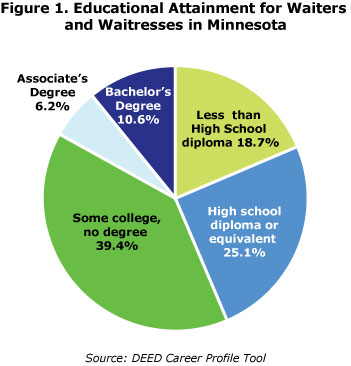by Cameron Macht
February 2017
Much like the food they deliver to their hungry customers, waiters and waitresses can sometimes find themselves operating in a pressure cooker environment. Responsible for greeting guests, taking orders, and serving food and beverages to customers at restaurants, bars, hotels, and other food service establishments, waitstaff often have to work quickly and efficiently under considerable pressure and with a minimum number of errors.
As front line employees bearing the responsibility for making sure that customers are satisfied with the food and the entire dining experience, waitstaff must work as a team with all the other members of the kitchen staff, including cooks, bartenders, dishwashers, and management. This requires excellent customer service, communication, and interpersonal skills.
Waiters and waitresses also need to be detail-oriented and must be able to describe items on the menu or make recommendations to customers. In addition, waitstaff also need the physical stamina to spend most of their time on their feet, often carrying heavy trays of food and dishes to and from the kitchen. It can be a challenging and demanding occupation in many ways.
With 48,500 people employed across the state, waiters and waitresses are among the top 10 largest occupations in Minnesota. Just over 60 percent of those waiters and waitresses are employed in the Twin Cities metro area, with the other 19,000 waitstaff spread across the other five regions (see Table 1).
| Table 1. Employment Projections for Waiters and Waitresses, 2014-2024 | ||||||
|---|---|---|---|---|---|---|
| Geographic Region | Estimated Employment, 2014 | Projected Employment, 2024 | Percent Change, 2014-2024 | Numeric Change, 2014-2024 | 2014-2024 Replacement Openings | 2014-2024 Total Openings |
| Minnesota | 48,458 | 48,638 | 0.3% | 180 | 23,320 | 23,500 |
| Twin Cities | 29,680 | 30,047 | 1.2% | 367 | 14,280 | 14,640 |
| Northwest | 4,523 | 4,395 | -2.8% | -128 | 2,170 | 2,170 |
| Central | 4,011 | 4,104 | 2.3% | 93 | 1,930 | 2,020 |
| Southeast | 3,670 | 3,626 | -1.1% | -44 | 1,760 | 1,760 |
| Northeast | 3,173 | 3,055 | -3.7% | -118 | 1,520 | 1,520 |
| Southwest | 3,163 | 3,048 | -3.6% | -115 | 1,520 | 1,520 |
| Source: DEED 2014-2024 Employment Outlook | ||||||
The occupation is not projected to see much new job growth in the next decade, but it still offers a tremendous amount of opportunity for jobseekers because of the many waitstaff who change jobs each year. In fact, with 23,320 replacement openings — an estimate of the need for new work force entrants to replace workers who leave an occupation — waiters and waitresses are projected to have the fourth highest number of total openings among all jobs in the state.
Waitstaff also had the seventh largest number of job openings in the most recent Job Vacancy Survey, with more than 2,000 current postings from employers across the state. As is usually the case, about 1,150 of those openings were located in Greater Minnesota, compared to just under 900 vacancies in the Twin Cities.Here's a Tip
Despite being one of the largest and most in-demand occupations in the state, it is also one of the lowest paying, at least based on median hourly wages reported by employers in the Occupational Employment Statistics (OES) program (see Table 2). Waiters and waitresses in Minnesota earned a median wage of $9.04 per hour. The 75th percentile wage was $9.53, meaning that 75 percent of waiters and waitresses in Minnesota earned less than that amount.
| Table 2. Hourly Wage Data for Waiters and Waitresses, 2016 | ||||||
|---|---|---|---|---|---|---|
| Geography | Employment | Wage Percentiles | ||||
| 10th | 25th | Median | 75th | 90th | ||
| Minnesota | 49,130 | $8.31 | $8.58 | $9.04 | $9.53 | $14.30 |
| United States | 2,505,630 | $8.16 | $8.71 | $9.34 | $11.76 | $17.31 |
| Source: DEED Occupational Employment Statistics | ||||||
Of course, most waitstaff get their earnings from a combination of hourly wages and customer tips, which can vary greatly depending on the popularity, location, and type of dining establishment in which they work. In general, tips are much higher in upscale restaurants, but can also be higher in larger metropolitan areas, at busier establishments, and for workers who provide exceptional service.
Once on the job, waiters and waitresses can work eccentric and unpredictable schedules, including early mornings, late evenings, weekends, and holidays. Nationally, about one in two waiters and waitresses worked part-time, and 67 percent of the job vacancies for waitstaff in Minnesota were for part-time work.
In addition to part-time, most waitstaff jobs are entry level, and no formal education or previous work experience is required to start working. Most waiters and waitresses learn the job through short-term on-the-job training, usually by following and learning from a more experienced member of the waitstaff who teaches them basic serving skills and the ins and outs of their particular establishment.
More sophisticated training programs might also help these new waiters and waitresses learn customer service skills, proper serving techniques, and how to deal with aggressive or hostile consumers. Typically this training lasts for only a couple of days or weeks before the new staff members are expected to be ready to work on their own. In Minnesota waitstaff who serve alcohol must be at least 18 years of age and should be familiar with state and local laws concerning the sale of alcoholic beverages.
While there are no formal educational requirements, it is interesting to note that nearly one in six waitstaff in Minnesota has a college degree, including more than 10 percent who have a bachelor's degree or higher (see Figure 1). Even if over-educated, many of the people who hold these jobs use them as a stepping stone in their career progression, picking up valuable skills along the way.
